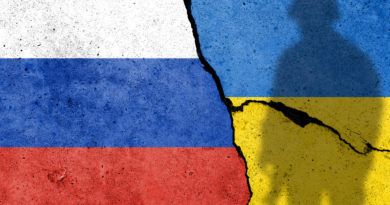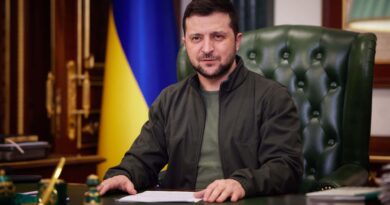’U.S. bioweapons labs in Ukraine’ claim is Russian disinformation

— Tucker Carlson, remarks on his Fox News show, the evening of March 9
Russian disinformation often begins with a speck of fact, which is then twisted into a full-blown conspiracy theory. The technique makes it easier to spread and take root among the country’s supporters. Note how quickly the party line uttered by the Russian Foreign Ministry was embraced by Carlson.
In this instance, Russia for years has been seeding the ground to claim that the United States set up biowarfare labs in Ukraine and other former Soviet republics. Then, brief remarks by Victoria Nuland, the undersecretary of state for political affairs, were twisted to provide “confirmation” of the disinformation program.
The Russian claims about Ukrainian labs bear the earmarks of the Soviet Union’s long-running campaign of false allegations that the United States used biological weapons. The KGB, for instance, in the early 1980s spread false claims that a U.S.-funded research project in Pakistan was sending “killer mosquitoes” into Afghanistan, leading to local outrage that ended the program.
After the Soviet Union collapsed, former officials admitted the fabrications. But Russian disinformation about biological weapons resumed again in earnest after Vladimir Putin took control in 1999, according to a 2021 article in the Nonproliferation Review by Milton Leitenberg of the University of Maryland. Leitenberg says the effort is designed to distract from Russian’s own biological weapons program.
Much as the Soviet Union tried to spread fear in Pakistan, Russian officials and media outlets bit by bit have sought to raise questions about U.S. labs in Ukraine and other former Soviet republics.
In 2015, the Russian state-owned news channel Rossiya-24 aired an alarming one-hour report. Tens of thousands of pigs in Ukraine and Georgia were dying because of a mysterious disease — and the reporter claimed U.S.-funded biological research facilities in those countries were to blame.
This was an enhanced version of an earlier claim. Three years earlier, Gennady Onishchenko, then the chief of Russia’s consumer protection agency, accused Georgia of “economic sabotage” by introducing the African swine fever (ASF) virus into Russia. He pointed the finger at the establishment a year earlier in Georgia of the Richard Lugar Center for Public Health Research, named after the U.S. senator who led efforts to eliminate dangerous weapons in former Soviet states. The facility was the first in the region that met Biosafety Level 3 standards, meaning it was equipped to study serious or lethal human diseases.
Onishchenko darkly noted that the lab’s director had once been Georgia’s intelligence chief and he could not understand why U.S. “military medics” and “epidemiologists” were stationed in Georgia “at our borders.”
Eventually, Russian officials alleged that ASF — which killed nearly 800,000 pigs in Russia and neighboring countries between 2014 and 2017 — was developed in the Georgia lab with the aim of curtailing Russia’s pork imports. (Never mind the outbreak started in 2007, four years before the lab opened.)
The attacks on the U.S.-funded labs in the region became even more pronounced after Britain in 2018 said the Russian government was responsible for the attempted killing of former Russian spy Sergei Skripal via the nerve agent Novichok.
Here are the specks of truth that Russian officials are using to spread their propaganda. The labs were initially funded by the Pentagon’s Defense Threat Reduction Agency (DTRA), as part of its cooperative biological engagement program. And the labs do study African swine fever — but with the aim of preventing its spread.
At a 2017 conference hosted by the DTRA, for instance, a Ukrainian official outlined laboratory efforts at improving the diagnosis, surveillance and prevention of ASF in wild boar populations. Another official discussed how Ukrainian scientists had implemented a program to monitor certain soft ticks, which transmit the disease to pigs. Then a third official presented on efforts to trace tularemia and anthrax in animals such as wild boars.
All of those efforts are in line with a statement posted on the website of the U.S. Embassy in Ukraine — that the program helps “ensure Ukraine can detect and report outbreaks caused by dangerous pathogens before they pose security or stability threats.” The United States and Ukraine in 2005 had signed an agreement under which the Defense Department, at no cost to Ukraine, would assist the Ministry of Health in making sure that Ukrainian labs studying diseases could not be used to develop biological weapons and in better detecting, diagnosing and monitoring infectious-disease outbreaks. The United States “has invested approximately $200 million in Ukraine since 2005, supporting 46 Ukrainian laboratories, health facilities, and diagnostic sites,” the Defense Department said in a fact sheet released Friday.
“The Russian charges that the Lugar Center and other biological labs in the Caucasus and Central Asia are making banned bioweapons are unfounded,” wrote biological threat expert Filippa Lentzos in 2018. “Last week a group of international experts, including this author, visited the Lugar Center by invitation of the Georgian government. We were given access to all areas of the site, examined relevant documentation, and interviewed staff, and concluded that the Center demonstrates significant transparency. Our group observed nothing out of the ordinary, or that we wouldn’t expect to see in a legitimate facility of this sort.”
Nevertheless, despite the constant debunking, the Russian propaganda that the United States has bioweapons labs in Ukraine has taken root, especially on the right, with the hashtag #usbiolabs trending on Twitter as the Russian invasion of Ukraine commenced. “Would the Russian invasion of Ukraine be justified if it were for biodefense?” asked Robert W. Malone, a prominent vaccine skeptic, on March 9.
The latest iteration of this claim was sparked by a brief exchange during a Senate hearing on March 8 between Sen. Marco Rubio (R-Fla.) and Nuland. Rubio asked whether Ukraine has biological or chemical weapons. Nuland responded by talking about the research labs and the U.S. concern that Russia would get access to them.
“Ukraine has biological research facilities, which, in fact, we are now quite concerned Russian troops, Russian forces, may be seeking to gain control of,” Nuland replied. “So, we are working with the Ukrainians on how they can prevent any of those research materials from falling into the hands of Russian forces should they approach.”
Following the lead of the Russian Foreign Ministry spokeswoman — who asserted Nuland’s comment was proof of the United States’ “illegal and criminal activity on Ukrainian soil” — Carlson and many others on the right jumped to the conclusion that this meant the labs really were biological weapons facilities.
Carlson briefly acknowledged numerous fact checks that previously had debunked the claim but then embraced the latest Russian spin as the truth. Russian state TV then featured Carlson’s take the next day, completing the circle.
Donald Trump Jr. gleefully tweeted a clip of Nuland, saying: “Well that went from conspiracy theory to Senate testimony in about 6 days … It used to take six months to go from conspiracy theory to fact.”
(Never mind that in 2020, during Trump’s father’s presidency, the State Department and the U.S. Embassy in Ukraine expressly denied Russia’s renewed claim that Ukraine possessed U.S.-funded bioweapon labs after China’s Foreign Ministry echoed that falsehood to distract from scrutiny of the origins of the coronavirus.)
In reality, Nuland’s statement about “biological research facilities” did not confirm allegations of bioweapons labs. African swine fever, for instance, is not a human pathogen. But it does devastate pigs and can be used as an economic weapon, so it is considered by the United States to be a potential biowarfare agent — especially in countries (such as the United States) with little experience with it.
In 2019, a group of Eastern European experts assessed that a “lone wolf” without any special training in microbiology, financial support or specialized lab equipment could launch such an attack. They said the ASF virus was especially dangerous because of its high virulence, lack of vaccine and devastating impact on pork production.
Asked on Thursday to expand on Nuland’s comment, Director of National Intelligence Avril Haines said medical facilities “all have equipment, pathogens or other things that you have to have restrictions around because you need to be sure it is being treated and handled appropriately.” She said there was a concern the Russians could misuse materials, even if not designed for weapons, “in dangerous ways or create challenges for the population.”
The World Health Organization, a U.N. agency, told Reuters Thursday that it had “strongly recommended to the Ministry of Health in Ukraine and other responsible bodies to destroy high-threat pathogens to prevent any potential spills.”
Andrzej Jarynowski, a Polish infectious-disease epidemiologist, said Kharkiv’s Institute of Experimental and Clinical Veterinary Medicine is one of the best labs between Greifswald, Germany and Pokrov, Russia — a distance of about 1,300 miles. He said ASF, Bacillus anthracis, avian Influenza viruses, Francisella tularensis, brucella, salmonella, E. coli (toxin producing), Borrelia sensu lato and the coronavirus were studied at Kharkiv, a city now under siege, with active agents stored until the invasion. Dangerous pathogens are kept in freezers, so a loss of electrical power due to the war could potentially allow for their escape.
Gigi Gronvall, an associate professor at the Johns Hopkins Bloomberg School of Public Health who for 10 years was on the Defense Department’s Threat Reduction Advisory Committee, said that it’s likely the Russians would not find much more at the labs on ASF than they already know, given the prevalence of ASF in Russia. But she recently published a study on the state of Russia’s life sciences research and found it to be anemic.
“If there was not a lab, the Russians still would say there was a lab there,” Gronvall said.
The Pinocchio Test
Under Putin, Russia has a biological weapons program, one that it has clearly used to target its opponents. Yet it tried to provide cover for its activities by repeatedly charging that the United States, through facilities it has funded in countries like Ukraine, has its own bioweapons program.
As we said, it’s straight out of the old Soviet playbook. But that doesn’t mean prominent commentators like Carlson should be so quick to fall for it.
Four Pinocchios
Send us facts to check by filling out this form
Sign up for The Fact Checker weekly newsletter
The Fact Checker is a verified signatory to the International Fact-Checking Network code of principles
This article has been archived for your research. The original version from The Washington Post can be found here.


